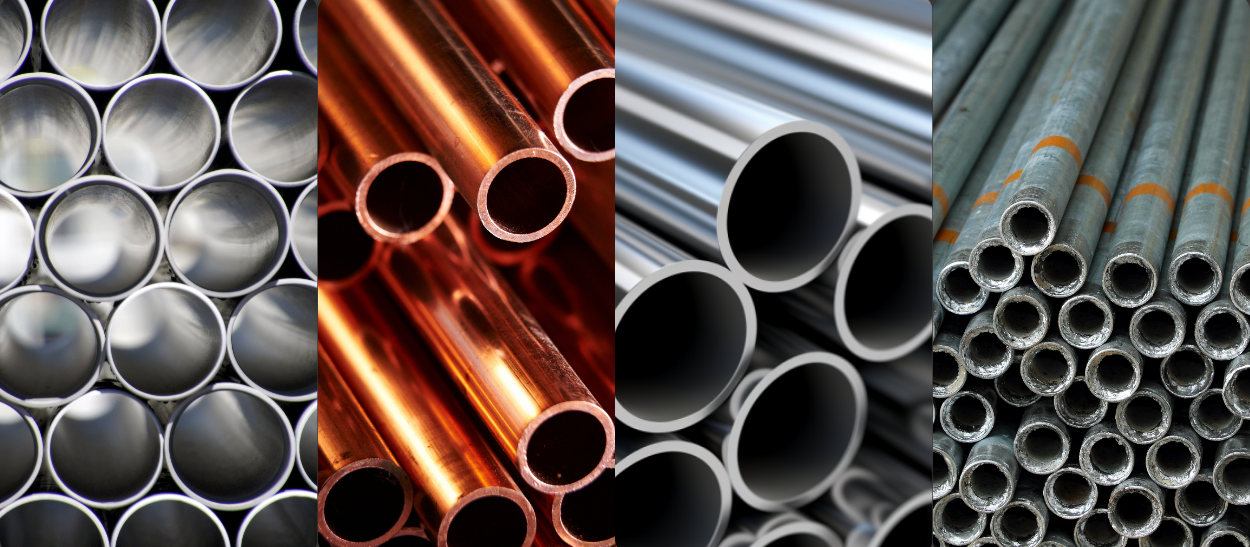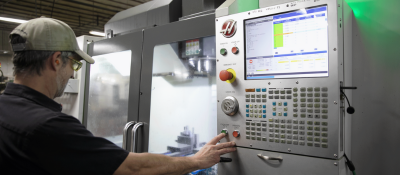Your Cart is Empty

Compressed Air Piping Best Practices: Materials, Installation, and Maintenance
Compressed air piping is a vital component of any compressed air system. Whether you’re delivering air to food packaging lines or providing medical air for hospitals, piping matters. This article will discuss piping type, installation best practices, and proper maintenance.
Estimated read time: 6 minutes
Table of Contents
- Choosing the Right Piping Material
- Piping Diameter
- Conducting an Audit
- Success Story: Food & Beverage
Setting up a compressed air system involves many components, and piping is an important one. With different piping material options, diameters, and installation methods, there’s a lot to think about when it comes to installing the right piping for your process and application. This guide will help you get started on the right foot.
Key Takeaways
- Select Appropriate Piping Materials — Choosing the right materials for compressed air piping is crucial for system efficiency and longevity. Materials like aluminum, copper, and stainless steel are often preferred due to their durability and resistance to corrosion.
- Proper Sizing of Pipe — Ensuring the correct diameter of piping minimizes pressure drops and maintains optimal airflow. Undersized pipes can lead to increased energy consumption and reduced system performance.
- Strategic Layout and Installation — Designing a piping system with minimal bends and avoiding unnecessary fittings reduces turbulence and pressure losses. A looped system can provide balanced pressure and improved reliability.
- Regular Maintenance and Leak Detection — Conducting routine inspections to identify and repair leaks is essential. Even small leaks can result in significant energy losses over time, impacting operational costs.
- Monitor and Optimize System Performance — Implementing pressure gauges and flow meters helps in monitoring the system's performance, allowing for timely adjustments and ensuring the system operates within desired parameters.
Choosing the Right Piping Material
Installing the correct piping material for your application is essential. Incorrect piping can cause hazards from corrosion to breakdowns and leaks. Most facilities use one of 5 types of piping:
1: Aluminum Pipe
This anti-corrosive pipe is easy to install. It’s lightweight and can be easily reconfigured if the system needs to be increased in size or relocated.
2: Copper Pipe
Copper pipe is resistant to corrosion, is lightweight, and is frequently used in plumbing. This is the most common type of piping for compressed air systems. Copper pipe uses standard fitting and joining techniques.
Pharmaceutical fields utilize copper piping as it inhibits microorganism growth.
3: Stainless Steel Pipe
This piping option is the most durable, as it is completely corrosion-resistant. Stainless steel piping is common in the medical field as well. It is NFPS-approved for vacuum applications.
4: Galvanized Steel Pipe
The galvanized coating of this pipe protects it from rust, which makes it a common piping option in many compressed air applications. However, galvanized steel can degrade over time and requires skilled workers to install.
5: Plastic Pipe
Plastic air pipes are easy to install and offer a cost-effective solution. However, PVC or CPVC is not recommended for carrying compressed air. PVC pipe can swell under the pressure of the compressed air, even exploding. Make sure the pipe you’re looking to use is OSHA approved.

Piping Diameter
Piping can come as small as ½” to 2.5”. The more air you need to move, the wider the piping needs to be in diameter. Installing piping with too narrow a diameter will result in the system operating at higher pressure, as large quantities of compressed air are forced through small pipes. Your facility also may experience inadequate quantities of air at the point of end-use.
Large piping also can double as storage. Some facilities utilize large receiver tanks to store compressed air, but this is not always an option. If you don’t have room for a receiver tank, use wider diameter piping to double as storage.
RELATED: VACUUM RECEIVERS: FULL OF VACUUM OR FULL OF MYTH?
Piping Installation and Maintenance
When installing pipe, make sure the piping takes the straightest path to the end use. Piping that includes more bends will experience higher pressure drop.
Another important factor to consider when installing pipe is future maintenance needs. Piping that is difficult to reach, underground, or in confined areas can be difficult to maintain and check for leaks.

Piping & Winter Conditions
In climates that experience cold winter conditions, pipes can freeze if not properly insulated. Insulating crawl spaces, ceilings, and gaps in the walls to keep the ambient temperature around the pipes warmer. Setting a low-temperature alarm system will alert you if the pipes are at risk of freezing.
Cooling water pipes for water-cooled air compressors should also be kept running in cold temperatures. If this cooling water freezes, the compressor can overheat. Consistently check to make sure that there is cooling water flowing through your system and monitor your compressor’s temperature levels so that you can adjust water temperatures as needed.
Insider Tip:A space heater is a great way to keep the compressor room warm and the system operating above freezing temperatures.
If your pipes run outside, you’ll need to insulate them to keep freezing at bay.
3 Popular Ways to Insulate Pipes:
- Use Pipe Insulation: a common choice of insulation is foam pipe insulation, which wraps around the pipes and provides a thermal barrier. In colder climates, fiberglass insulation works better than foam insulation. Thermal insulation wraps provide better protection against extreme temperatures and can be made from different types of material.
- Heat Tape or Heating Cables: These cables are wrapped around the pipes to provide either constant heat or automatically adjust heat output based on ambient temperature. These must be properly sized for the length of pipe and power supply.
- Pipe Lagging: Thermal blankets are used around larger pipes or in areas where other insulation options may not be feasible. Thermal blankets help keep the temperature of the pipes consistent.
RELATED: PREPARING YOUR COMPRESSED AIR SYSTEM FOR WINTER
Finding & Fixing Piping Leaks
Leaks in piping can be a huge drain of energy and valuable compressed air. Finding and fixing leaks can save you hundreds in energy bills.
To find all leaks in your system, a formal leak audit can be performed with ultrasonic leak detectors. These detectors can be used in loud environments where leaks cannot be heard. The audit team will log data, evaluate the findings and present a solution to resolve the leaks in your system.

Conducting an Audit
A detailed compressed air energy audit examines the function and energy performance of a compressed air system with data collection as a core feature. With some training and engineering experience, an individual can perform a compressed air audit. The existing system operation is examined and analyzed to create a system baseline. The baseline is the existing state of the system before any changes or upgrades are made.
After the baseline system analysis is complete, the data is analyzed using statistical computer models to simulate new operational setpoints to predict energy savings through equipment upgrades. Some energy savings prediction software is readily available. Many energy auditors have built their own proprietary simulation models, including our audit team at Rogers Machinery Company.
The data is typically compiled into a report with the proposed solutions, and energy incentives (if available) are estimated.
When the changes have been made and the upgrades installed, data is collected once again to tune the system and verify the accuracy of the predicted energy savings.
The final step is to set up periodic checks or have permanent sensors installed to ensure the system’s efficiency for years to come.
RELATED: BENEFITS OF AIR SYSTEM AUDITS: WHEN YOU NEED ONE & HOW TO DO THEM
Success Story
A food & beverage manufacturer in the Pacific Northwest requested an audit on their 1,000 CFM system. Multiple buildings in their facility were connected by 1.5” pipe. To mitigate pressure drop, two compressors fed the system from two different buildings, both operating at elevated pressure. This system resulted in multiple operating pressures, suboptimal system controls, and overall elevated pressure. The facility experienced high energy and operating costs.
After conducting an air audit, the Rogers team proposed a few upgrades. Here’s what they did:
- Added a parallel 3” header to connect buildings
- Added storage tanks at the end of the line
- Moved both compressors (225 hp total) into one room, moved them to a backup state and replaced them with one 200hp compressor
- Reduced the average compressor operating pressure by 15psi
These upgrades resulted in 20% reduced energy consumption, stabilized system pressure, improved controls, and lowered maintenance costs.

Whether you’re delivering air to food packaging lines or providing medical air for hospitals, the piping your facility uses matters. Consult your local Rogers Machinery expert to provide piping advice and schedule an air audit to determine your piping system’s efficiency.
Meet the Contributor
 |
Ryan French joined the Rogers Machinery Audits and Consulting Group fresh out of college in 2021. Prior to entering the industry full time, he conducted plant-wide industrial energy assessments for three years with the Oregon State University Industrial Assessment Center. |





